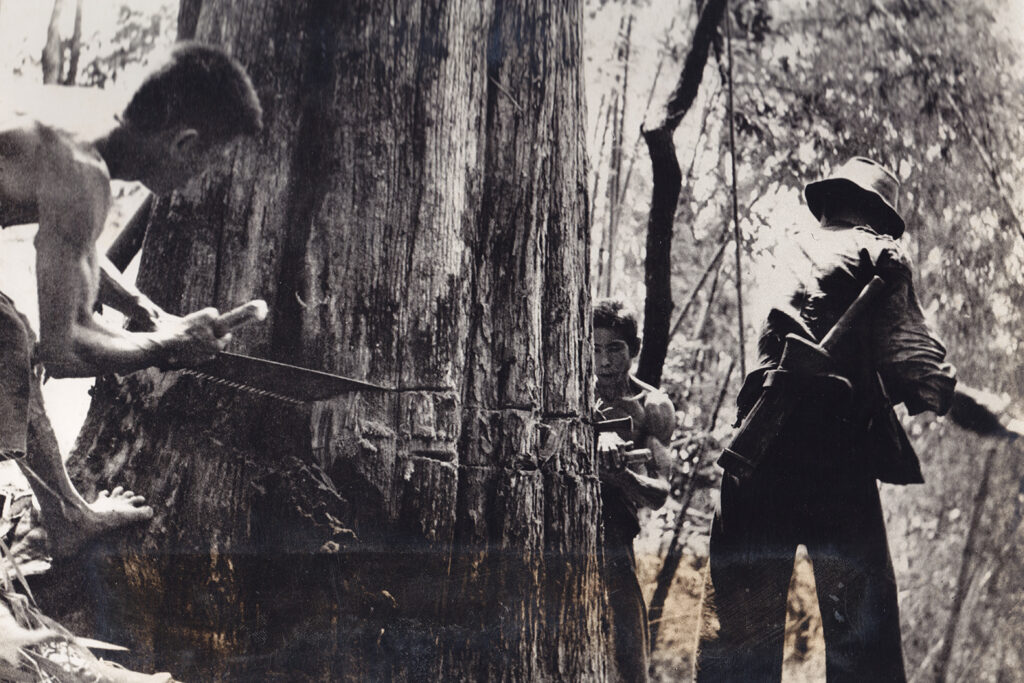
องค์การอุตสาหกรรมป่าไม้ / Forest Industry Organization
ย้อนอดีตกลับไปยังปีที่ 5 แห่งการเสวยราชสมบัติของพระบาทสมเด็จพระจุลจอมเกล้าเจ้าอยู่หัว สหราชอาณาจักรได้เข้ามาเปิดบริษัทประกอบธุรกิจการทำไม้ในนามของบริษัทบอร์เนียว ซึ่งได้รับสัมปทานจากรัฐบาลไทย ต่อมามีการนำเครื่องจักรกลเข้ามาเพื่อตั้งโรงเลื่อย และใช้ช้างนับร้อยเชือกในการชักลากไม้ กระทั่งในปี พ.ศ. 2455 กรมป่าไม้ได้ดำริให้มีการฝึกพนักงานป่าไม้ ให้มีความชำนาญในการนำไม้สักออกจากป่า เพื่อจะได้ลดข้อบกพร่องต่างๆ ในขั้นตอนการทำไม้ ตลอดจนการวางมาตรการควบคุมผู้ที่ได้รับอนุญาตให้ปฏิบัติตามกฎระเบียบได้ถูกต้อง ในปี พ.ศ. 2476 จึงได้มีพระราชกฤษฎีกากำหนดจัดตั้งกองทำไม้ มีหน้าที่ดำเนินการนำไม้สักออกมาจำหน่ายในลักษณะรัฐพาณิชย์ ช่วงหลังสงครามโลกครั้งที่ 2 รัฐบาลได้ยุบกองทำไม้ และตั้งเป็น องค์การอุตสาหกรรมป่าไม้ (อ.อ.ป.) โดยกำหนดเอาวันที่ 1 มกราคม 2490 เป็นวันก่อตั้ง ล่วงมาจนถึงวันที่ 25 กรกฎาคม 2499 องค์การอุตสาหกรรมป่าไม้จึงปรับเป็นนิติบุคคล สังกัดกระทรวงเกษตรและสหกรณ์
During the fifth year of the throne of King Rama V, the Thai government granted a concession for forestry to the Borneo Company of the United Kingdom. With the addition of mill machinery, elephants were being used to drag the fallen logs. Until the year 1912, the forest department provided training to staff in the skills needed to both bring teak wood from the forest and to reduce defects in its processing. In 1933 the stockpile of government timber was released commercially. On January 1, 1947, after World War II, the government established the “Forest Industry Organization” (FIO). On July 25, 1956, the FIO was incorporated under the Ministry of Agriculture.
ในอดีตนั้น อ.อ.ป. มีช้างงานมากกว่า 150 เชือกกระจายอยู่ทั่วภาคเหนือ เพื่อช่วยในการชักลากไม้ตามป่าสัมปทานต่าง ๆ ซึ่งในการชักลากไม้ต้องใช้ช้างทั้งเพศผู้และเพศเมียทำงานร่วมกัน โดยมีอัตราส่วนของทั้งสองเพศเท่า ๆ กัน และจากการที่มีช้างงานจำนวนมากเช่นนี้ จึงมีลูกช้างเล็ก ๆ เกิดขึ้นทุกปี ลูกช้างนั้นจะต้องอยู่กับแม่ช้างและกินนมแม่อยู่นาน 3 – 4 ปี จึงจะสามารถแยกออกไปฝึกได้ ทำให้เป็นภาระต่อหน่วยช้างที่มีช้างแม่ลูกอ่อน และลูกช้างมากกว่าครึ่งต้องล้มตายลงจากอุบัติเหตุ เช่น สัตว์มีพิษและสัตว์ร้ายในป่าทำร้าย
In the past, there were more than 150 elephants engaged in logging in the forest concessions of the north. Logging required both male and female elephants equally. Each year, some of the working female elephants would give birth. Baby elephants must stay with mothers about 3 to 4 years before
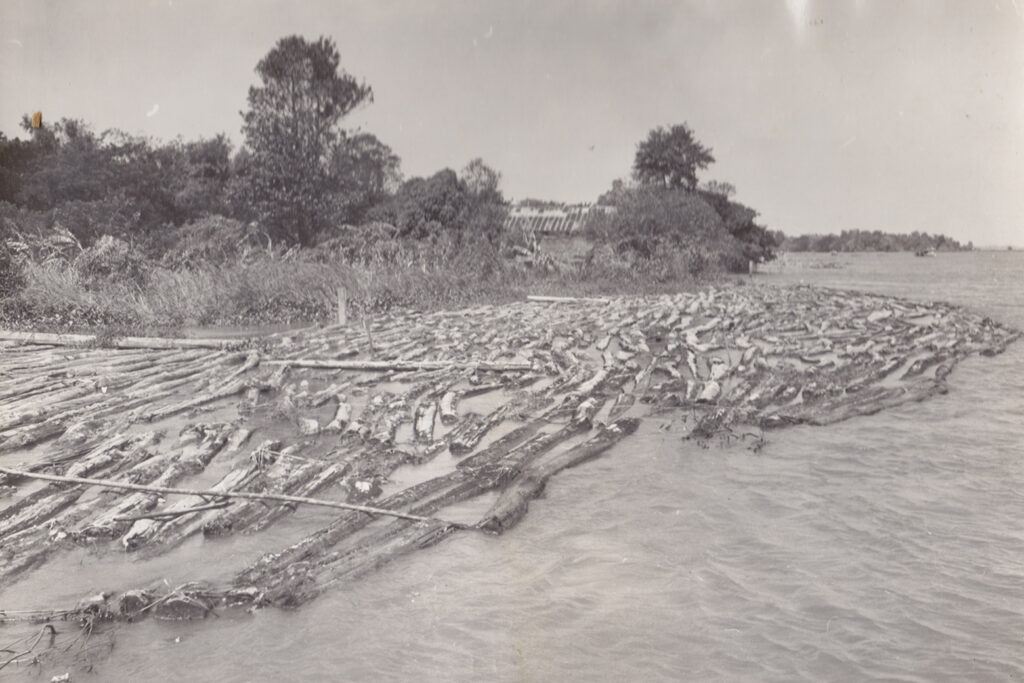
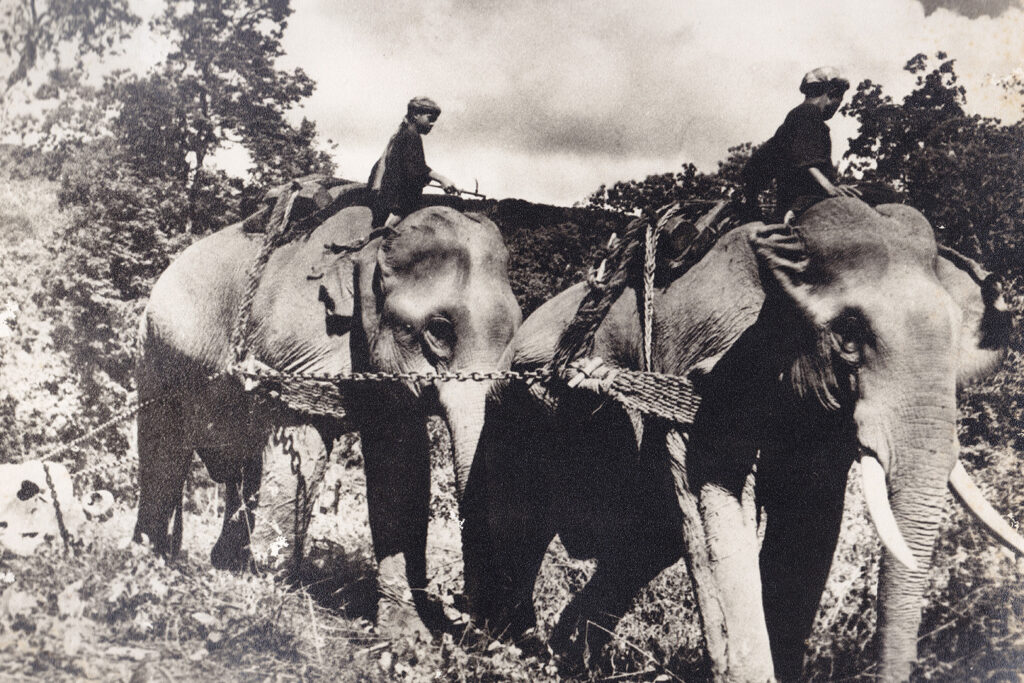
สถาบันคชบาลแห่งชาติ ในพระอุปถัมภ์ฯ / National Elephant Institute
ในปี พ.ศ. 2512 ศ.ดร.อำนวย คอวนิช อดีดผู้อำนวยการ อ.อ.ป. ซึ่งในขณะนั้น ดำรงตำแหน่งหัวหน้ากองทำไม้ภาคเหนือ ได้มองเห็นปัญหาดังกล่าว จึงได้ตั้ง “ศูนย์ฝึกลูกช้าง” ขึ้นที่บ้านปางหละ ตำบลบ้านหวด อำเภองาว จังหวัดลำปาง

โดยมีวัตถุประสงค์ดังนี้ คือ
- เพื่อฝึกลูกช้างให้มีความอดทน แข็งแรง และมีความชำนาญในการทำไม้ทุกประเภท
- เพื่อฝึกลูกช้างให้มีนิสัยดี เชื่อฟังคำสั่ง ไม่ดุร้าย
- เพื่อแยกลูกช้างออกจากแม่ เพื่อให้แม่ช้างมีโอกาสทำงานเต็มที่
- เพื่อให้ลูกช้างมีความปลอดภัยจากสัตว์ร้าย เช่น งูพิษ ฯลฯ
- เพื่อให้ลูกช้างอยู่ในความดูแลอย่างใกล้ชิดกับสัตวแพทย์
สามารถกล่าวได้ว่าศูนย์ฝึกลูกช้างแห่งนี้เป็นศูนย์ฝึกลูกช้างทำไม้แห่งแรกและแห่งเดียวในโลก มีชื่อเสียงเป็นที่รู้จักแพร่หลายทั้งในและต่างประเทศ จะเห็นได้ว่าการใช้ช้างในอุตสาหกรรมป่าไม้นั้นดำเนินมานานนับร้อยปี และสืบเนื่องเรื่อยมาโดยองค์การอุตสาหกรรมป่าไม้เป็นหลัก จนกระทั่งทางรัฐบาลได้ออกพระราชกำหนดยกเลิกสัมปทานป่าไม้ทั่วประเทศลง ในวันที่ 17 มกราคม 2532 ทำให้ช้างเอกชนจำนวนมากและช้างขององค์การอุตสาหกรรมป่าไม้ไม่มีงานทำ ช้างขององค์การอุตสาหกรรมป่าไม้ ได้รวบรวมนำมาไว้ที่ศูนย์ฝึกลูกช้างบ้านปางหละ บางส่วนกระจายอยู่ตามสวนป่าของ อ.อ.ป. แต่ยังพบว่ามีช้างของเอกชนบางส่วน มีการลักลอบทำไม้ผิดกฎหมายอย่างต่อเนื่อง และเพิ่มขึ้นทุกปี โดยกลุ่มช้างทำไม้ผิดกฎหมายเหล่านี้มีจำนวนประมาณ 2,000 – 2,500 เชือก ซึ่งแต่ละเชือกสามารถทำรายได้ประมาณ 50,000 – 100,000 บาท ต่อเดือน ช้างกลุ่มนี้จะถูกใช้งานอย่างหนัก เนื่องจากเป็นงานที่ผิดกฎหมาย บางครั้งต้องทำงานในตอนกลางคืน บางครั้งเจ้าของให้กินยาบ้า ใช้ไฟเผากัน ใช้มีดหรือหอกแทง มีการลงโทษอย่างรุนแรง เพื่อบังคับให้ช้างทำงานได้มาก ๆ เมื่อเจ้าหน้าที่ของรัฐจับกุมผู้กระทำผิดและจับช้างได้ ก็จะส่งช้างของกลางดังกล่าวมาให้องค์การอุตสาหกรรมป่าไม้เป็นผู้ดูแลเพื่อรอศาลตัดสิน ซึ่งสภาพช้างของกลางที่อยู่ในความดูแลขององค์การอุตสาหกรรมป่าไม้ มักมีสภาพทรุดโทรม บางเชือกก็พิการ หลังหัก ขาหัก ตาบอดหรือมีบาดแผลทั่วทั้งตัว นับว่าศูนย์ฝึกลูกช้างบ้านปางหละเป็นแหล่งรวมช้างที่ใหญ่ที่สุดในขณะนั้น
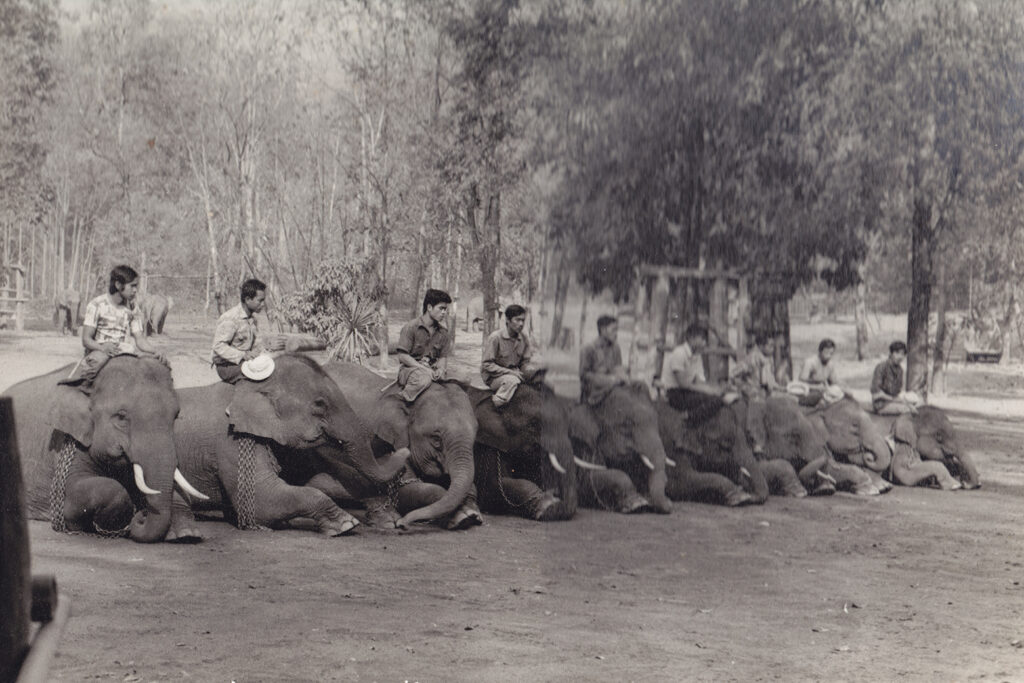
In 1978, Prof. AmnuayKorwanich, the former director of the Forest Industry Organization (FIO), took notice of a growing national problem and decided to establish a training center for baby elephants at Ban Pang La, Ngao district, Lampang.
The 1978 Objectives included:
- To keep the baby elephants in close proximity to the care of a veterinarian.
- To keep baby elephants safe, especially from poisonous creatures like snakes (cobra or king cobra).
- To train baby elephants to be gentle, obedient, and to have good habits.
- To train baby elephants to have the patience and strength to do any kind of wood work.
- To eventually separate the babies from parents in preparation for full time work.
This was the first and only center in the world that trained elephants, and its reputation was well known both domestically and internationally.
The use of elephants in Thai society and the forest industry has existed for hundreds if not thousands of years. FIO continued this work until January 17th, 1989 when the government issued a nation-wide decree ending logging contracts throughout Thailand. This impacted both FIO’s elephants as well as Thailand’s privately-owned elephants, and left a lot of elephants and mahouts unemployed.
At that time, FIO gathered elephants from the training camp at Ban Pang La and others scattered among the FIO forestry plantations. There was still some privately-owned elephant smuggling and illegal logging that continued, and it increased every year. The illegally-working elephant numbers grew to 2,000-2,500, with each one earning about 50,000-100,000 THB per month. The elephants that were put to work illegally would often be forced to work at night. Some owners were also known to give the elephants amphetamines and subject them to cruel punishment, forcing them into heavy work that often resulted in injuries and illness.
When government agents arrested these culprits, their confiscated elephants would be taken to FIO to be cared for while awaiting legal and court decisions. The elephants that were brought to FIO were often dilapidated or disabled, some with broken legs, blindness, or other bodily injuries. The training center at Pang La became home to the largest number of elephants at that time.
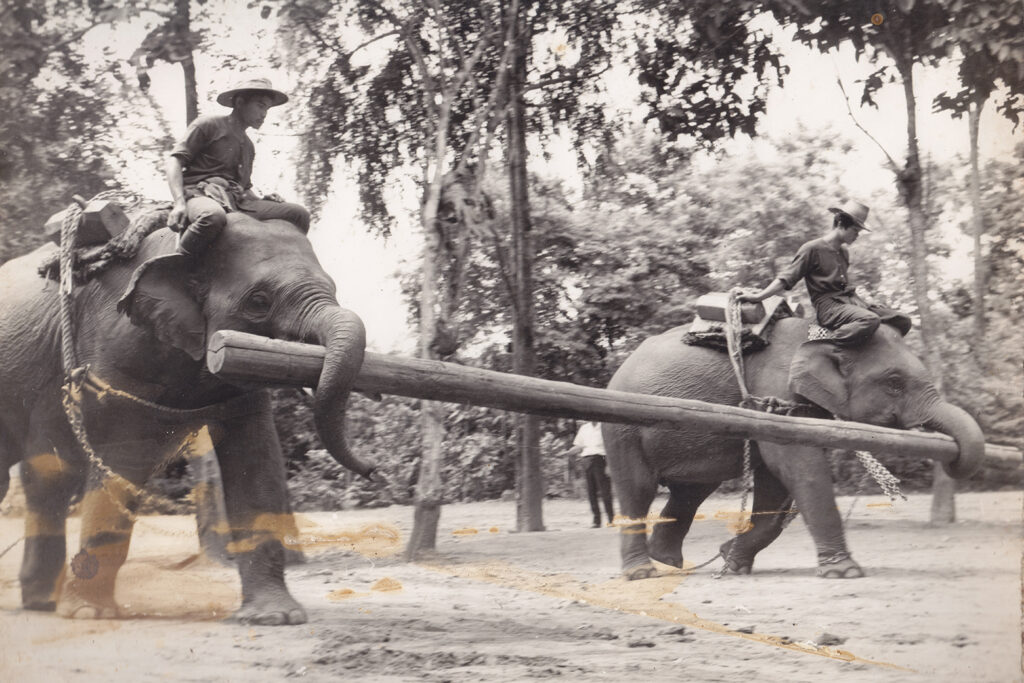
ล่วงมาถึงปี พ.ศ. 2534 ซึ่งเป็นปีที่สมเด็จพระเทพรัตนราชสุดาฯ สยามบรมราชกุมารี เจริญพระชนมายุครบ 3 รอบ ในวันที่ 2 เมษายน 2534 องค์การอุตสาหกรรมป่าไม้จึงถือเป็นนิมิตหมายที่จะได้ร่วมเฉลิมพระเกียรติในวโรกาสอันเป็นมงคลนี้ด้วยการย้ายศูนย์ฝึกลูกช้าง ซึ่งมีเนื้อที่จำกัดไม่เหมาะกับสภาพการณ์ ที่มีช้างฝึก ช้างแก่ ช้างเจ็บป่วยและช้างของกลางรวมอยู่เป็นจำนวนมาก มาจัดตั้งเป็น “ศูนย์อนุรักษ์ช้างไทย” แทนศูนย์ฝึกลูกช้างเดิม โดยได้รับการอนุมัติจากกระทรวงเกษตรและสหกรณ์ให้ใช้พื้นที่จำนวน 383 ไร่ ติดต่อกับสวนป่าทุ่งเกวียนบริเวณทางหลวงสายลำปาง – เชียงใหม่ (ช่วงหลักกิโลเมตรที่ 28 หมู่ 6ตำบลเวียงตาล อำเภอห้างฉัตร จังหวัดลำปาง) ซึ่งสมเด็จพระเทพรัตนราชสุดาฯ สยามบรมราชกุมารี ได้ทรงเสด็จมาเปิดศูนย์อนุรักษ์ช้างไทย เมื่อวันที่ 4 มีนาคม 2535 เพื่อเป็นการอนุรักษ์ศิลปะและเอกลักษณ์การทำไม้ด้วยช้างของไทยไว้ และยังจะเป็นแหล่งรวบรวมข้อมูล ความรู้เกี่ยวกับเรื่องช้าง เพื่อการศึกษาค้นคว้า หรือทำงานวิจัยอันจะเป็นจุดเริ่มต้นของการจัดตั้งองค์การสากลเพื่ออนุรักษ์ช้างในประเทศไทย ซึ่งในเบื้องต้นศูนย์อนุรักษ์ช้างไทยมีช้างอยู่ในครอบครองมากที่สุดประมาณ 117 เชือก
Three years later, in 1991, FIO had the vision together with Princess MahaChakriSirindhorn that they would move the auspicious elephant training center from Ban Pang La to a larger area. There were many confiscated elephants at Ban Pang La, where there was limited space for training them and caring for the old, sick, and injured. With approval from the Ministry of Agriculture, 777 acres were designated for a new “Thai Elephant Conservation Center” (next to ThungKwian Forestry plantation on Lampang-Chiang Mai highway M.6 Wiang Tan, Hangchat district, Lampang). Princess MahaChakriSirindhorn attended the opening of the Thai Elephant Conservation Center on March 4, 1991. The Center’s goals were to provide a source of information about elephants for present study research and to preserve the historic ways elephants had been utilized as workers in the forests in the past. At present, there are approximately 80 elephants in residence at the Center.
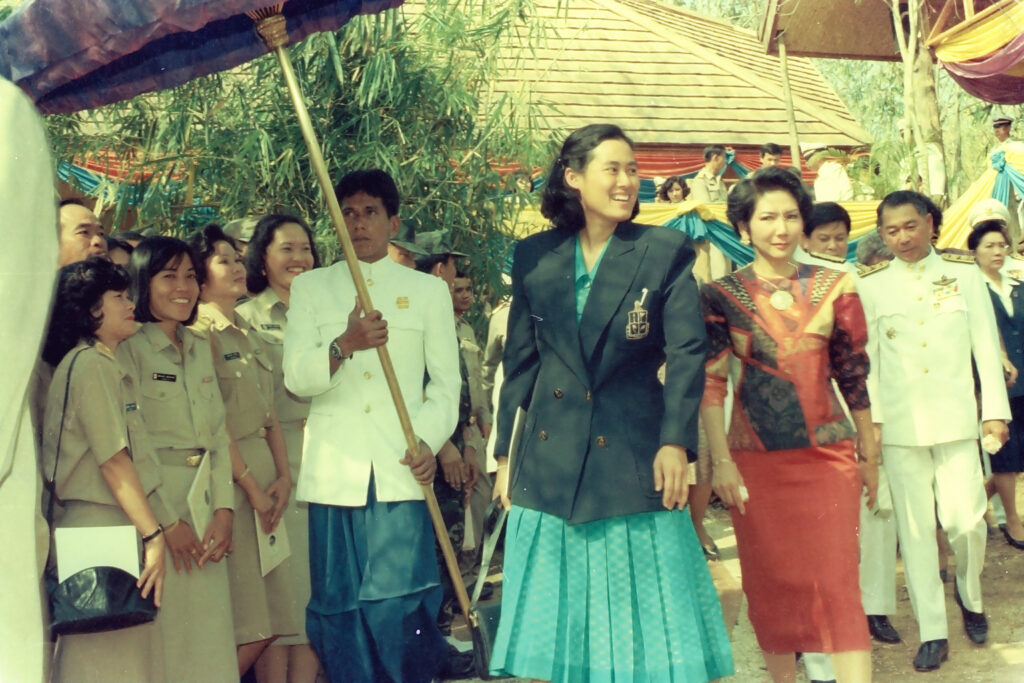

ในวันที่ 13 มกราคม 2545 สมเด็จพระเจ้าพี่นางเธอเจ้าฟ้ากัลยาณิวัฒนา กรมหลวงนราธิวาสราชนครินทร์ ได้เสด็จเยี่ยมช้างในพระอุปถัมภ์ฯ ช้างพังพระธิดาและช้างพังวนาลี ตลอดจนทรงเสด็จเยี่ยมกิจกรรมของศูนย์อนุรักษ์ช้างไทย ผู้อำนวยการองค์การอุตสาหกรรมป่าไม้ ได้กราบทูลถวายรายงานความตั้งใจที่จะยกฐานะของศูนย์อนุรักษ์ช้างไทยขึ้นเป็นสถาบันคชบาลแห่งชาติ โดยมีวัตถุประสงค์เพื่อขยายขอบเขตของการบริบาลช้างไทยให้ครอบคลุมทุกแง่ทุกมุมในการบรรเทาปัญหาที่เกิดกับช้าง เพื่อให้เกิดแนวทางในการอนุรักษ์ช้างอย่างยั่งยืนพร้อมกับอนุรักษ์ประเพณีวัฒนธรรมการเลี้ยงช้างไว้เป็นมรดก ให้สามารถสืบทอดต่อชนรุ่นหลังต่อไป จากนั้นวันที่ 22 กุมภาพันธ์ 2545 สมเด็จพระเจ้าพี่นางเธอเจ้าฟ้ากัลยาณิวัฒนาฯ ได้ทรงพระกรุณาโปรดเกล้าฯ รับสถาบันคชบาลแห่งชาติ ไว้ในพระอุปถัมภ์ ซึ่งนับว่าเป็นสิริมงคลและเป็นมิ่งขวัญในการพัฒนาสถาบันคชบาลแห่งชาติ ในพระอุปถัมภ์ฯ ให้เจริญต่อไป
In 2002, the late Princess GalyaniVadhana came to visit the patronage elephants, Pang PhraThiDa and Pang Wanalee and witness the activities at the Thai Elephant Conservation Center. The FIO director reported his intention to raise the status of the Elephant Conservation Center to become the “National Elephant Institute.” Their objective being to further develop the care of their elephants while mitigating the problems with approaches to elephant conservation and sustainability. With respect to local indigenous methods and elephant conservation, on February 22, 2002 the late Princess GalyaniVadhana received the National Elephant Institute in patronage. (orig: This is the prosperity and development of the center mascot for the next flourish.) The development of this center will help the future of Thailand’s dependent elephant population to flourish and prosper.
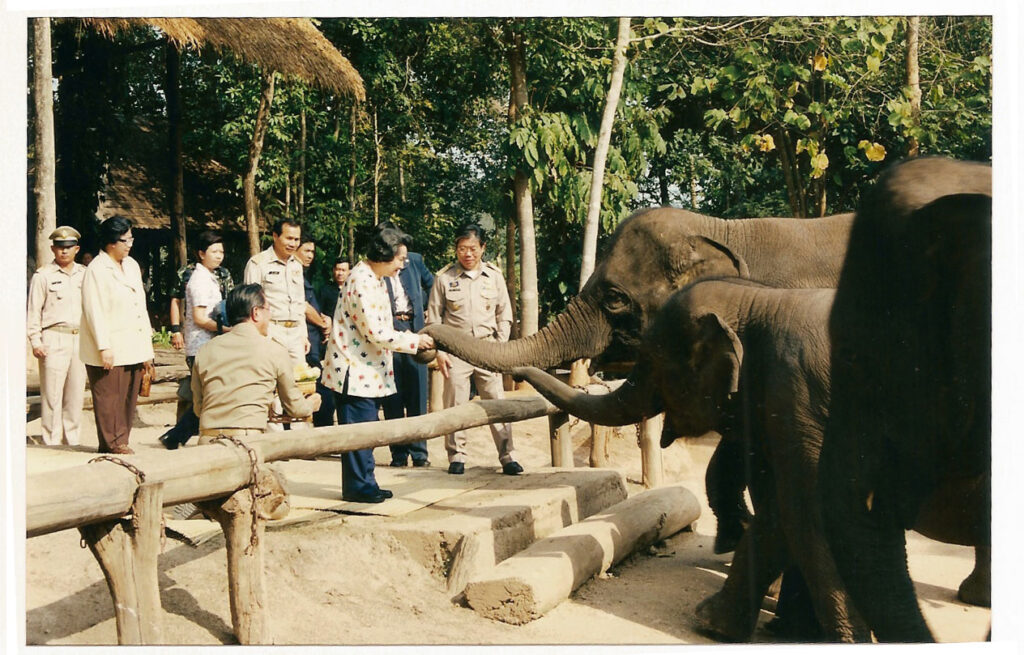
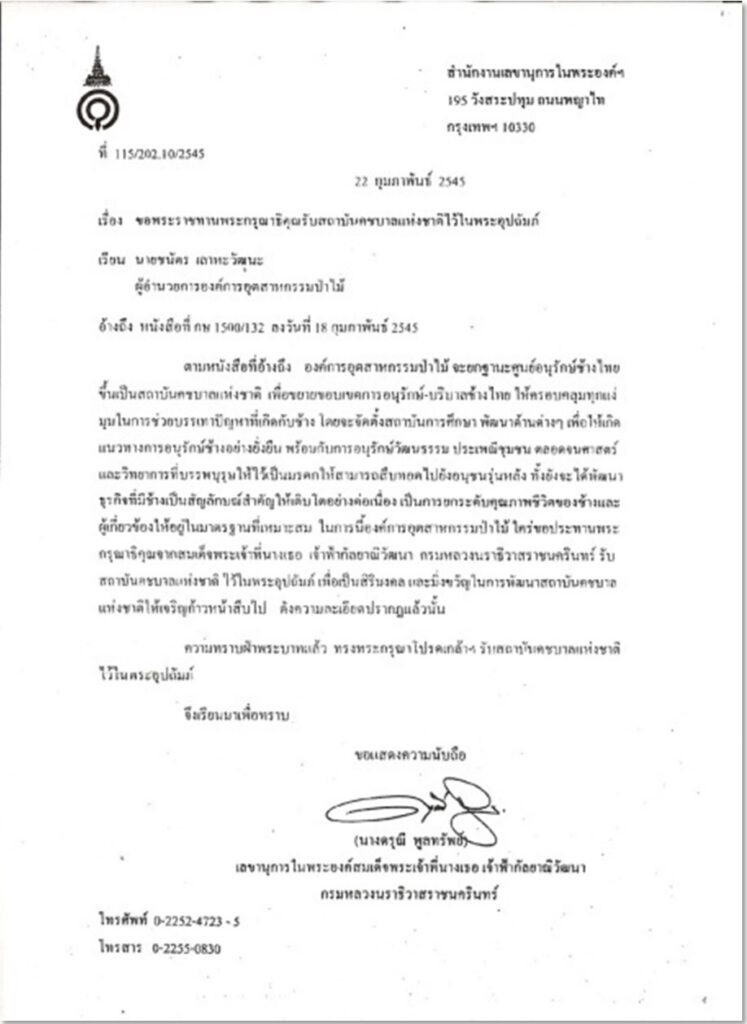
22 กุมภาพันธ์ 2545 ทรงรับสถาบันคชบาลแห่งชาติไว้ในพระอุปถัมภ์ฯ
February 22nd, 2002 Received the National Elephant Institute in patronage
